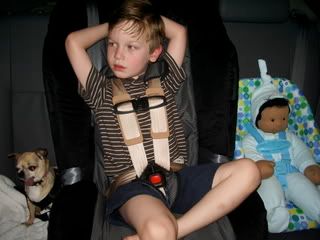
Today marks the start of a week dedicated to Child Passenger Safety. As most of you know, that's a topic I'm very passionate about. A fellow mommy-blogger interviewed me for an article on her blog, and it occurred to me that I should probably write a post of my own.
There is a lot to know about choosing and using a car seat, but here I present my Top Five Tips for Keeping Your Kids Safe in the Car.
1. Keep your child rear-facing as long as possible.
One year and 20 pounds is so 1990s. The new recommendation is to keep children rear-facing to the limits of their seat. With seats that now have tall shells and can support children to 35, 40, or even 45 pounds, most kids can rear-face for years. Anna will remain rear-facing until she's at least 3 years old, and possibly to 4 or beyond.
We would all be better off riding rear-facing, but that's not an option for adults. Little kids are lucky enough to be able to, so let them.
2. Keep your child in a harness until he's mature enough for a booster.
Just because you can put a toddler or preschooler in a booster doesn't mean you should. Until a child is mature enough to sit in a booster without lunging around and playing with the seatbelt, he should stay in a harnessed seat. We don't recommend boosters until kids are at least 4 years old, but it really depends on the kid. Elias, who has always taken car safety very seriously, didn't ride in a booster until he was 5, and even then it was only-part time. Now that he's 6, he's finally in one full-time. (And even now we have to remind him now and then to stay in position--though in his defense, when he leans over he's usually trying to help retrieve a toy that Anna has thrown down.)
3. Keep your child in a restraint (harness or booster) until the seatbelt fits PROPERLY on its own.
Under California law, my son is old enough to ditch the booster and ride in the seatbelt alone. As CPSTs like to say, though, the laws of physics trump the laws of man. An ill-fitting lap belt can cause terrible internal damage, like ruptured organs and severed spinal columns. When a shoulder belt rubs against a kid's neck, she's likely to put it behind her back, setting up the perfect scenario for head trauma in a crash since nothing is there to restrain the torso.
That's why my children won't ride without a booster until the lap belt fits low on the hips (not on the tummy), the shoulder belt sits across the middle of the shoulder, they can sit all the way back against the seat, their knees bend comfortably at the edge of the seat (to prevent inevitable slouching, which would make the lap belt ride up), and they can stay that way for the entire trip.
4. Know your seat, know your vehicle.
Read the manuals. Really. They're boring and tedious, but they're also full of extremely important information. You might find that not all the information you need to know is included (for example, if you own a Honda, you won't learn that you have to stop using LATCH when your child weighs 40 pounds), but you'll know more than you did when you started. Maybe you'll learn that you can't use LATCH in the center of your car. Maybe you'll learn that your child restraint can't touch the seat in front of it (check the airbag section). Maybe you'll learn that your car seat has an expiration date, or that you can't have your infant seat's handle up in the car. The manuals are a wealth of information. So read them. For real.
5. Get your seat inspected.
Find a Child Passenger Safety Technician and have them check your installation. Many people think they can just go down to the fire or police station, but the reality is that most public servants are not CPSTs. (That doesn't stop many well meaning firefighters from trying to help, but that can put you in a worse position than when you started.) So make sure whoever is helping you is a certified technician. You can find one near you at the SafeKids website or from this thread at car-seat.org. If you're in Orange County, CA, you can get in touch with Safety in Motion for an appointment or to learn about free events.
Sadly, not all technicians are up-to-date on their information or training. A good technician will make sure you install your seat and are comfortable doing so. They won't pressure you to turn your child forward-facing or move to a booster or seatbelt before he/she is ready. They won't tell you to install your seat in a way that contradicts the instructions. (How will you know that? Read your manuals, remember?)
If you want more information on Child Passenger Safety, these are some great resources:
car-seat.org
carseatblog.com
carseat.org
Have a safe and happy week!

Great post! I did not know there was a week dedicated to Child Passenger Safety . . . I should do something similar on my blog :)
ReplyDeleteGreat post! Sharing on Facebook.
ReplyDelete